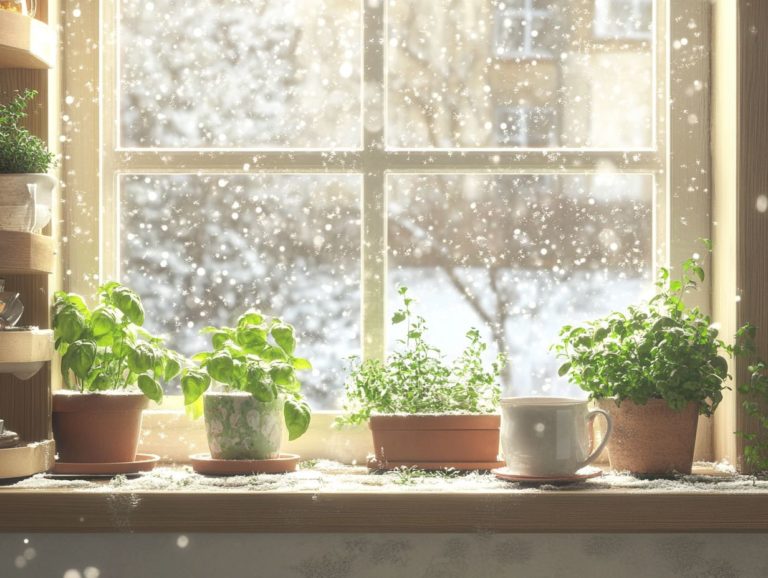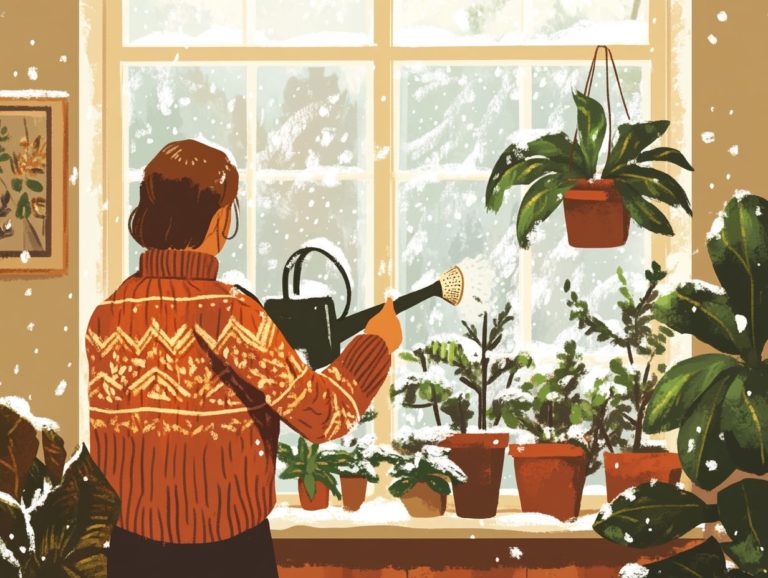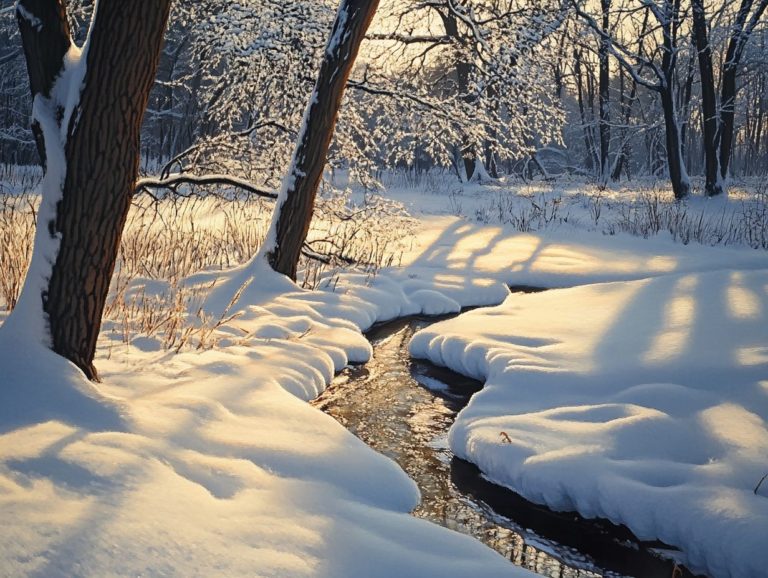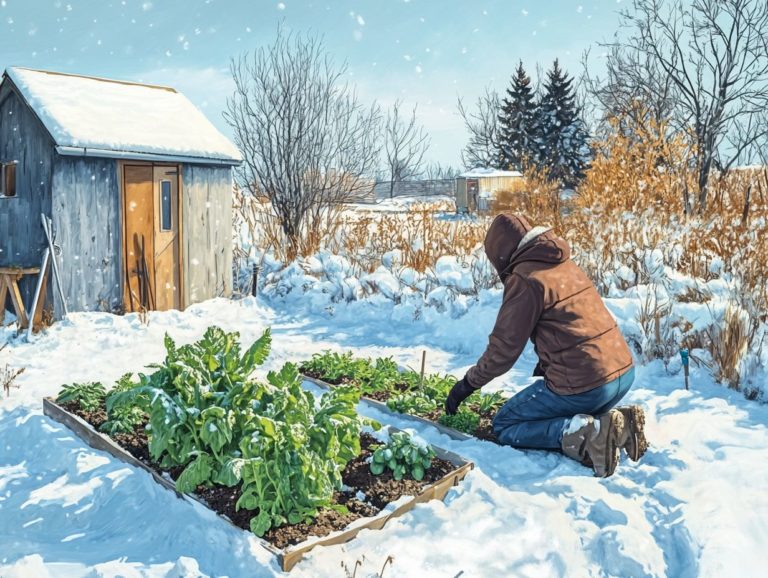Building a Winter Garden: Step-by-Step
Winter gardening may seem daunting, but it offers a fantastic chance to grow beauty and nourishment during the colder months.
From selecting resilient plants that thrive in chilly temperatures to preparing your soil and crafting a cozy garden layout, this guide is packed with everything you need to create a stunning winter oasis!
Discover valuable tips for planting and maintenance, including strategies to protect your greens from harsh weather.
Embrace the season and enjoy the rewards of your winter garden!
Contents
- Key Takeaways:
- Why Winter Gardening is Beneficial
- Choosing the Right Plants for a Winter Garden
- Preparing Soil for Winter Gardening
- Creating a Winter Garden Plan
- Preparing for Winter: Planting and Maintenance
- Protecting Your Winter Garden
- Harvesting and Enjoying Your Winter Garden
- Frequently Asked Questions
- What are the benefits of building a winter garden?
- What materials do I need to build a winter garden?
- How do I choose the right location for my winter garden?
- Do I need any special tools for building a winter garden?
- What are some important factors to consider when building a winter garden?
- Can I build a winter garden on my own or should I hire a professional?
Key Takeaways:
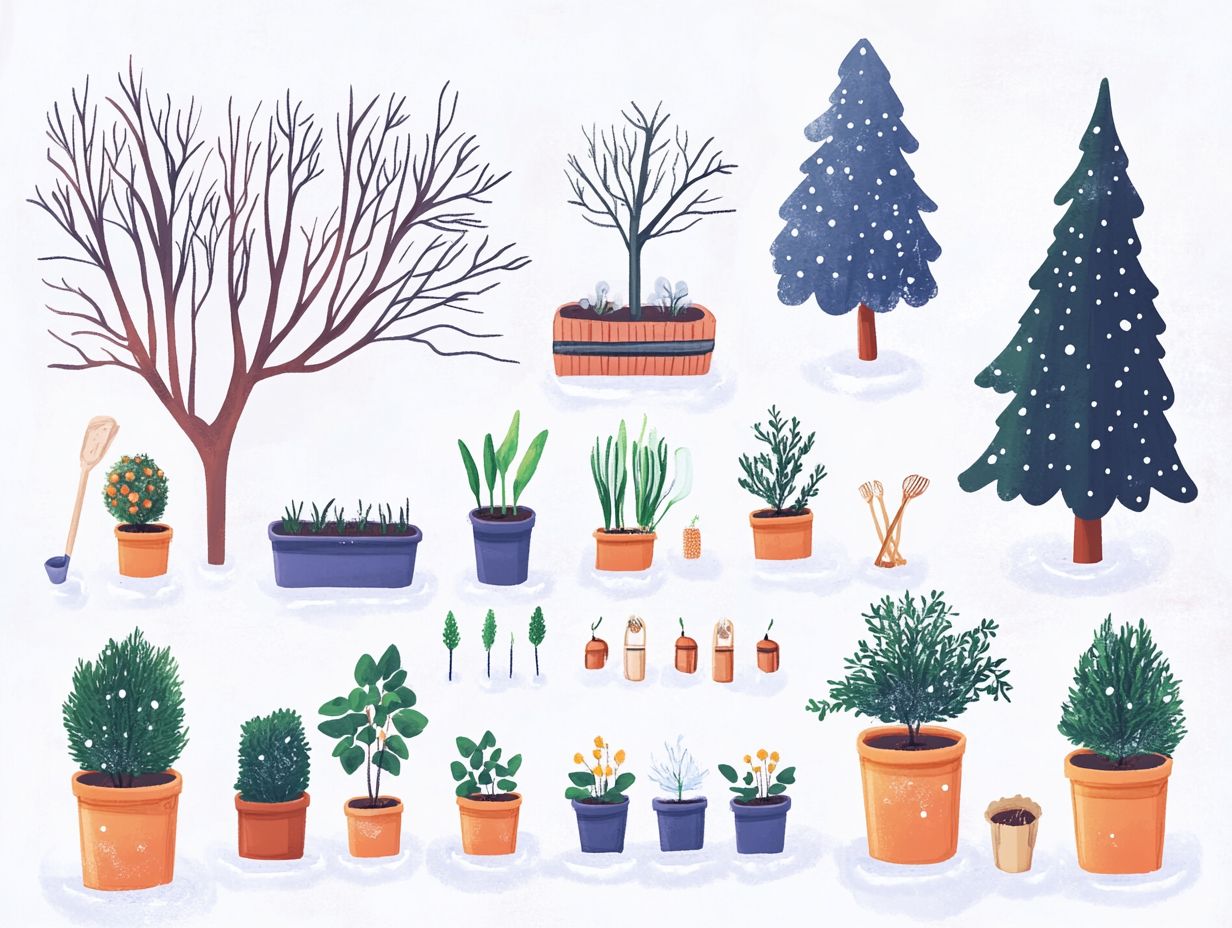
- Winter gardening provides fresh produce and boosts mental well-being.
- Choose cold-hardy plants and improve your soil with organic matter.
- Plan your garden design to maximize sunlight and vertical space.
Why Winter Gardening is Beneficial
Winter gardening is a wonderful way to maintain the beauty of your landscape while fostering the variety of living things and enhancing how healthy your soil is.
By planning a winter garden, you can explore a range of winter planting ideas featuring vibrant flowers, evergreen shrubs, and aromatic plants that thrive in the winter chill. Additionally, learning how to build a cold frame for winter gardening can further enhance your gardening experience.
This effort not only boosts the visual appeal of your outdoor space but also invites wildlife into your garden, all while offering the potential for a bountiful harvest of winter crops.
Ultimately, your garden can become a year-round source of both interest and utility.
Choosing the Right Plants for a Winter Garden
Selecting the perfect plants for your winter garden is key to creating visual allure and seasonal charm. Blend evergreen shrubs with vibrant winter plants and aromatic varieties that flourish in cooler temperatures.
Incorporate ornamental grasses to add texture and vertical elegance, while a selection of winter flowers ensures you enjoy beautiful blooms even during the coldest months.
This thoughtful approach transforms your winter garden into an enchanting retreat.
Types of Plants that Thrive in Winter
Imagine your winter garden thriving with various plants that keep your outdoor space vibrant during the colder months. Evergreen shrubs, colorful winter blooms, and fragrant plants are excellent choices, as they not only survive but also add delightful texture and fragrance to your garden.
Ornamental grasses can be a fantastic addition, providing movement and visual interest, even when frost covers the ground.
Among your options, consider Betula utilis, known for its striking white bark that offers a stunning contrast against the winter landscape. Cornus sanguinea, with its vibrant red stems, adds an eye-catching element that s hard to ignore. These plants enhance the beauty of your garden while serving functional roles, like providing shelter for wildlife.
Maintenance is manageable: just ensure they re well-watered before the freeze sets in and prune selectively to encourage healthy growth. The combination of these trees and shrubs will enrich your winter garden, transforming it into a serene sanctuary amidst the harshness of the season.
Start planning your winter garden today and enjoy a beautiful, thriving space all season long!
Preparing Soil for Winter Gardening
Get your soil ready for winter gardening! This crucial step ensures thriving plants and healthy soil even in the cold. By improving soil structure and fertility, you boost the overall health of your garden and its strength against harsh conditions. This preparation involves incorporating organic matter, ensuring proper drainage, and conducting soil tests to monitor nutrient levels.
Start by adding compost to enrich the soil and stimulate beneficial microbial activity. This creates a vibrant ecosystem that supports your plant roots and enhances nutrient absorption. You can also mix in amendments like peat moss or aged manure to significantly improve moisture retention, which is crucial during dry winter spells.
Covering the soil with mulch is another great strategy. It insulates the ground and helps regulate temperature fluctuations that can stress your plants. These maintenance strategies work wonders for your soil health, ensuring that your winter garden not only survives but thrives even when temperatures drop.
Creating a Winter Garden Plan
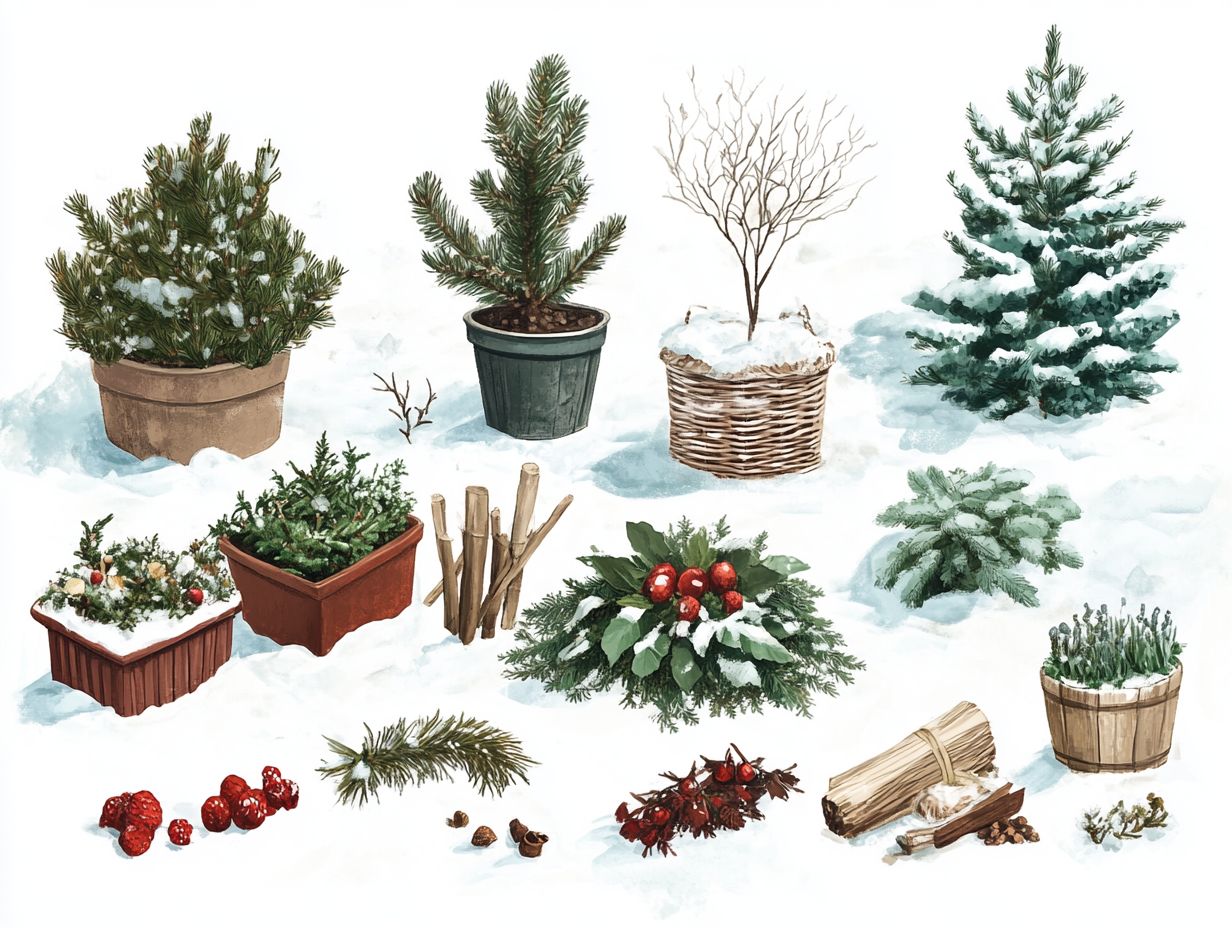
Crafting a well-thought-out plan for your winter garden is essential to enhance both its beauty and utility throughout the colder months. Begin by exploring a variety of winter garden ideas and preparing your garden for winter, considering elements like layout, plant selection, and seasonal appeal.
Embracing container gardening introduces versatility to your design, allowing you to experiment with various arrangements while adding captivating vertical drama to your space.
Design and Layout Tips
Designing a visually captivating winter garden requires careful attention to layout and plant placement. Embrace winter garden ideas that highlight vertical drama while ensuring a harmonious flow throughout the space. If you’re looking to protect your plants, consider learning how to build a cold frame for winter plants. Container gardening can significantly elevate your design, offering flexible arrangements that adapt beautifully to the changing seasons.
While focusing on vertical elements, remember the importance of plant height for creating an inviting atmosphere. Position taller varieties at the back or center, gradually transitioning to medium and shorter plants for a balanced look.
A color palette that either contrasts or complements the winter landscape enhances visual appeal imagine rich greens against a snowy backdrop or vibrant reds and yellows that draw the eye.
And let s not forget about texture. Mixing smooth leaves with fuzzy or spiky ones adds depth to your design, transforming your winter garden into a visual delight and a true feast for the senses.
Preparing for Winter: Planting and Maintenance
Preparing for winter gardening requires a thoughtful blend of strategic planting and diligent maintenance to ensure your plants not only survive but thrive. It s crucial to understand the optimal timing and techniques for planting, especially for delicate overwintering plants that need extra care to flourish in the colder months.
Regular maintenance is key for your winter garden. Engaging in practices like precise pruning and effective mulching significantly protects your plants and enhances their strength against harsh winter elements.
When and How to Plant
Knowing when and how to plant your winter garden is essential for ensuring the success of your winter plants.
For instance, root vegetables like carrots and parsnips should ideally be sown in late fall, allowing for gradual germination as the soil cools. Conversely, leafy greens like spinach can be seeded in early winter for a delightful spring harvest.
Using techniques like cold frames (structures that protect plants from cold weather) or cloches (protective covers for individual plants) adds an extra layer of protection, shielding your tender plants from harsh winds and frost. Insulating your garden beds with mulch not only retains soil warmth but also promotes healthier growth.
By tailoring your planting schedule to the climate and specific needs of your plants, you can significantly enhance your winter yields.
Winter Garden Maintenance Tips
Effective maintenance of your winter garden is crucial for keeping your plants healthy and vibrant throughout the colder months. Engage in tasks like mulching, watering, and protecting delicate plants to maintain soil health.
By following a consistent maintenance schedule, you ll prepare your winter garden for a flourishing comeback in spring.
Consider insulating sensitive plants with burlap or frost cloth. This protects them against harsh winds and freezing temperatures.
Monitor soil moisture levels; winter can be deceptively dry. Water periodically to prevent drying out.
Feeding winter birds and beneficial insects contributes to a balanced ecosystem. These steps enhance your garden’s resilience and create a thriving habitat for wildlife.
Protecting Your Winter Garden
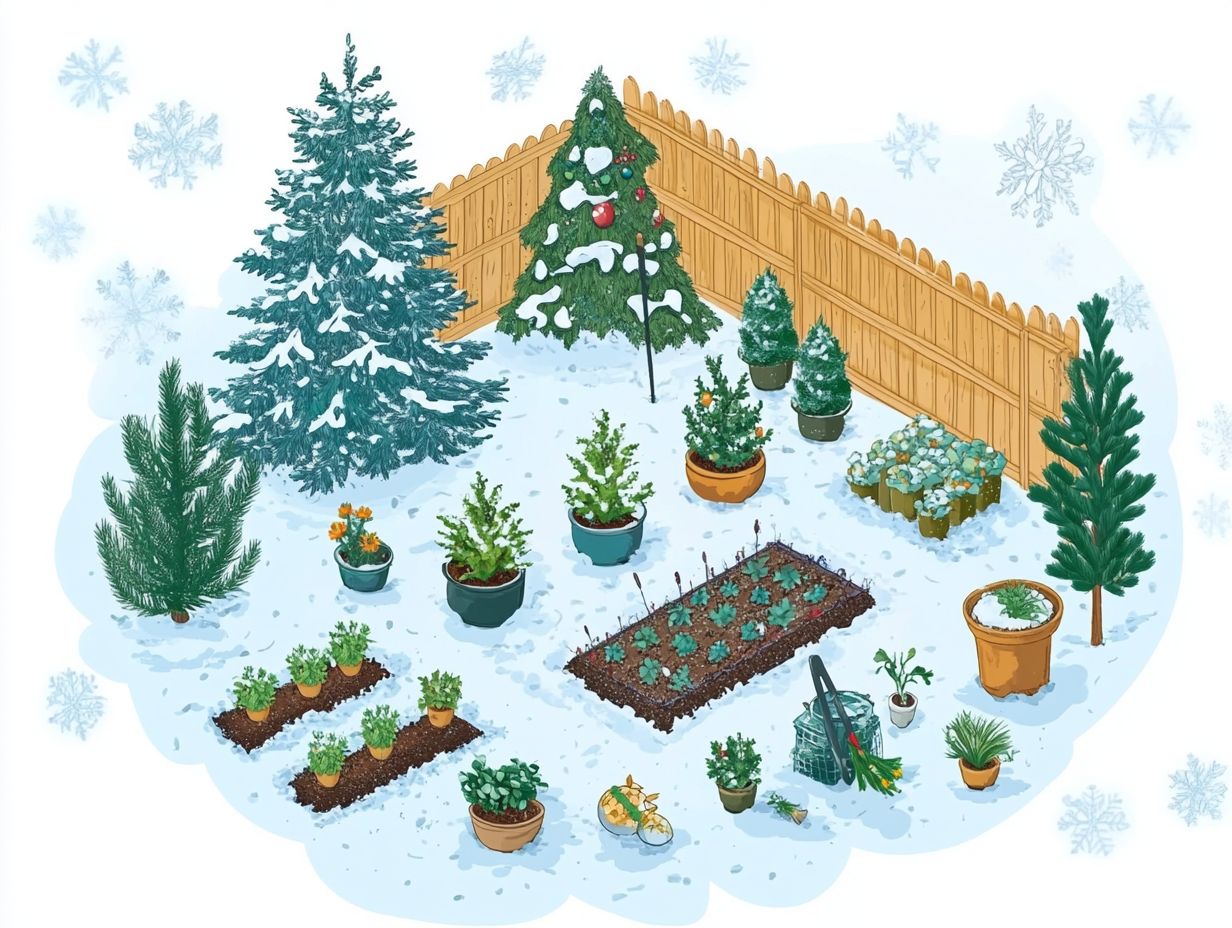
Protecting your winter garden from harsh conditions is essential for your precious plants. Consider using strategies like mulching, cloches, and cold frames, and learn more about creating the right setup in our guide on how to create a winter gardening toolkit to shield delicate plants from extreme cold.
These measures fortify your garden’s resilience and enhance its aesthetic appeal, allowing you to enjoy a lovely landscape even in winter.
How to Shield Plants from Harsh Winter Conditions
Shielding your plants can dramatically boost their survival chances. Use cold frames or cloches to create a favorable small area with different weather conditions.
Proper placement of these structures is crucial for maximizing protection. Select the right materials; using insulated fabrics or mulches can significantly boost warmth retention.
Position barriers in sunlit areas to maintain stable temperatures. Elevating pots prevents unwanted cold absorption.
For a natural approach, surrounding tender perennials with straw or leaves acts as a wonderful insulator, helping them withstand the chill.
Harvesting and Enjoying Your Winter Garden
Harvesting and savoring the fruits of your winter garden is one of the most rewarding joys of winter planting. It lets you truly reap the benefits of your hard work.
A diverse array of winter crops, from vibrant leafy greens to hearty root vegetables, awaits you, brightening those colder days.
By incorporating these elements into your winter gardening practice, you not only elevate your culinary experiences but also strengthen your bond with the garden.
Tips for Harvesting and Using Winter Produce
Harvesting winter produce demands specific techniques to capture the best quality and flavor from your crops. Knowing the right moment to harvest is essential.
Picking leafy greens and root vegetables at their best will enhance your cooking. Incorporating fresh winter produce into meals highlights the benefits of growing vegetables in colder months.
Timing is key and varies depending on the crops you’re cultivating, as each plant has its own unique signs of readiness. For instance, you should wait until after the first frost to harvest winter kale, because that s when its flavor sweetens beautifully. Carrots, on the other hand, are ready to be dug up once their foliage starts to turn yellow.
To make the most of these greens and root vegetables, think about blending them into hearty soups or crafting vibrant salads that showcase a delightful mix of textures and tastes. Simple methods like steaming or roasting can bring out the rich flavors of winter produce, making your meal prep both effortless and delicious.
Such careful harvesting and cooking can deepen your appreciation for seasonal bounty.
Frequently Asked Questions
What are the benefits of building a winter garden?
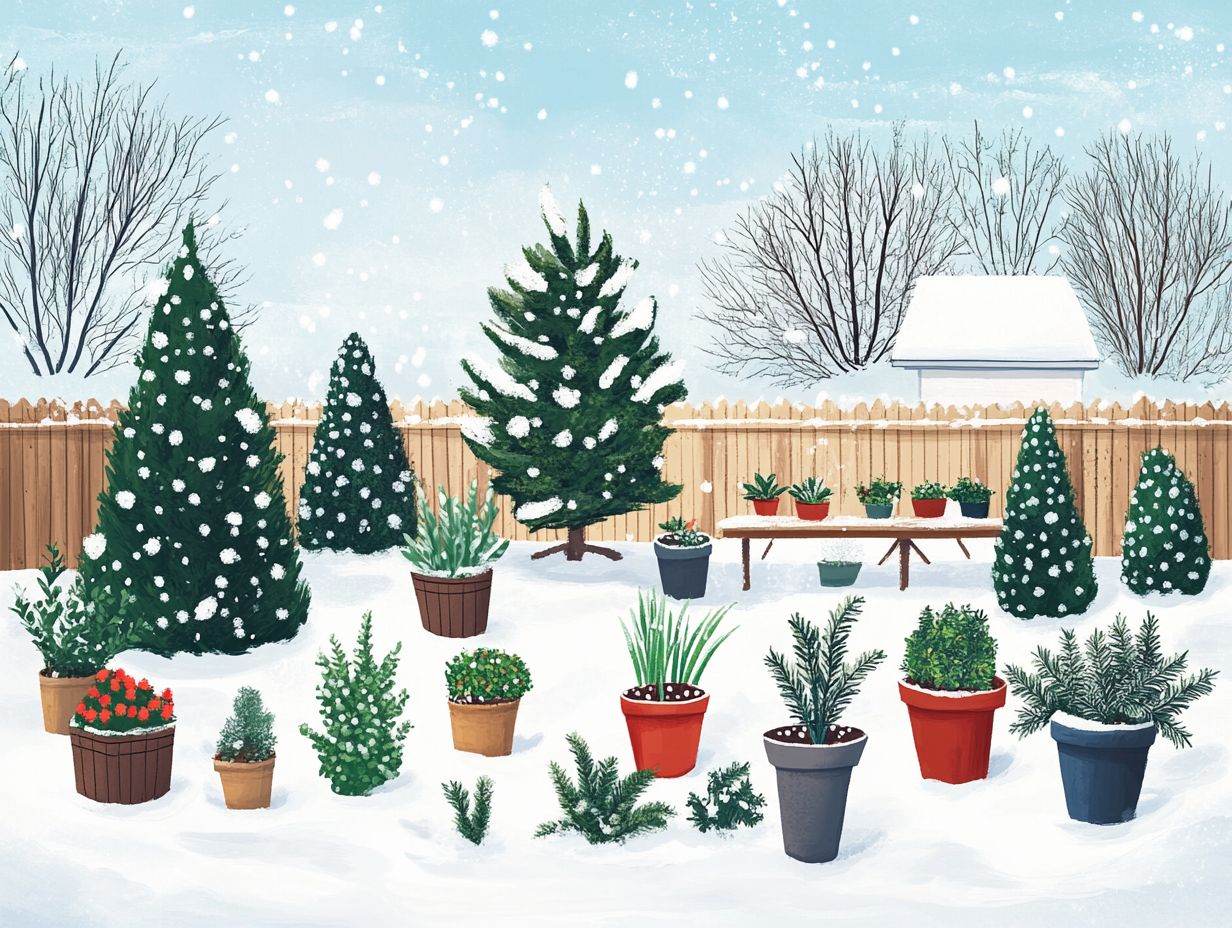
A winter garden lets you enjoy fresh produce and beautiful plants all year, no matter the weather. For families, planning a winter garden for kids adds value to your home and creates a cozy spot for relaxation.
What materials do I need to build a winter garden?
You will need the following materials: a suitable location, clear plastic sheeting or glass panels for the walls and roof, lumber or metal for the frame, insulation, and a heating system.
How do I choose the right location for my winter garden?
The ideal location for a winter garden is an area that receives plenty of sunlight and is protected from harsh winds. For more detailed guidance, check out this article on how to create a winter garden atmosphere. It should also be easily accessible from your home and have good drainage.
Do I need any special tools for building a winter garden?
Yes, you will need basic construction tools such as a saw, hammer, drill, and measuring tape. You might also need special tools to cut and install the plastic or glass panels.
What are some important factors to consider when building a winter garden?
Some important factors to consider are the size of your winter garden, the types of plants you want to grow, the climate in your area, and your budget. For more detailed guidance, check out this resource on how to create a winter garden design. It’s also important to plan for proper ventilation and drainage in your winter garden.
Can I build a winter garden on my own or should I hire a professional?
It is possible to build a winter garden on your own, but it can be a complex and time-consuming project. For those interested in creating a winter garden design, if you have little experience with construction or gardening, it may be best to hire a professional to ensure proper installation and functionality of your winter garden.
Ready to start your own winter garden? Explore more about winter gardening today!


